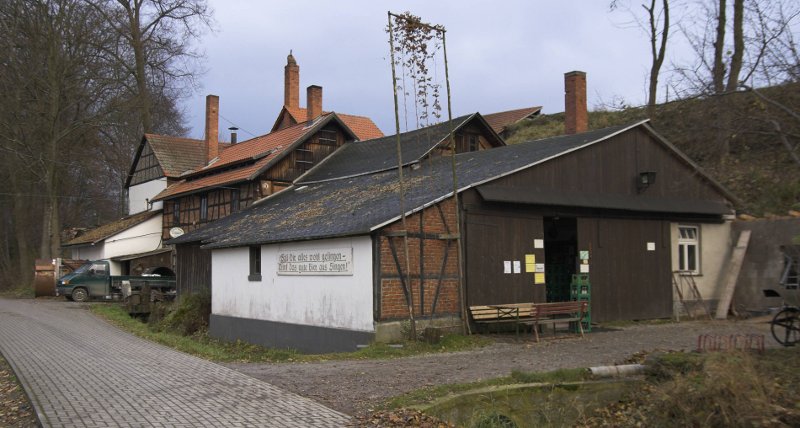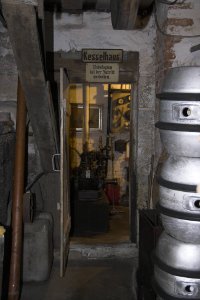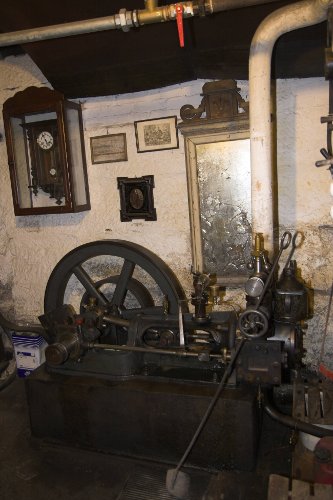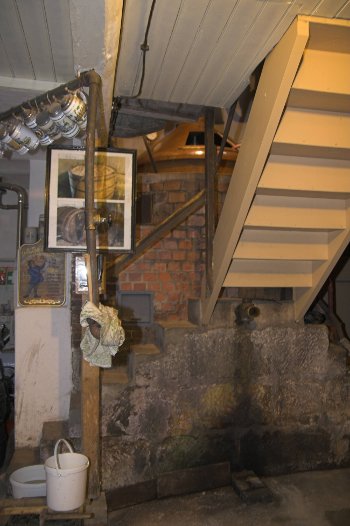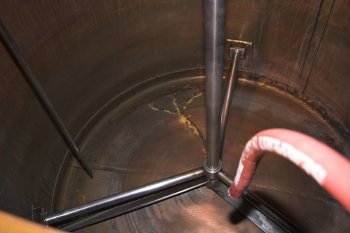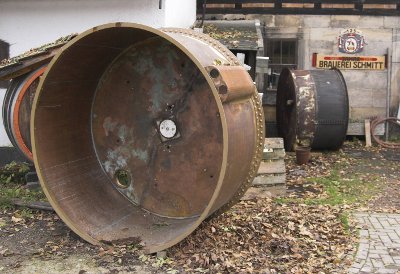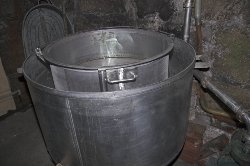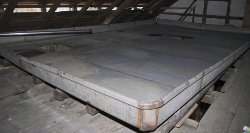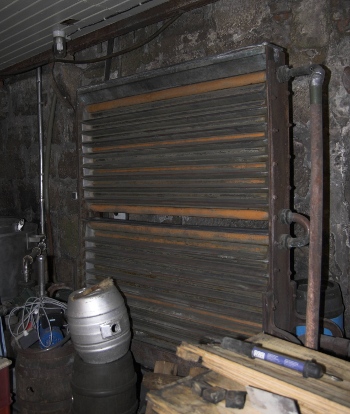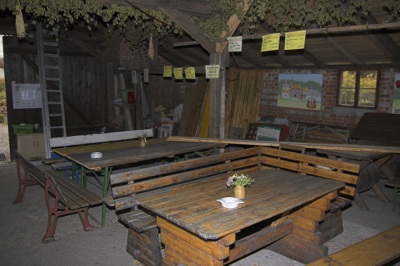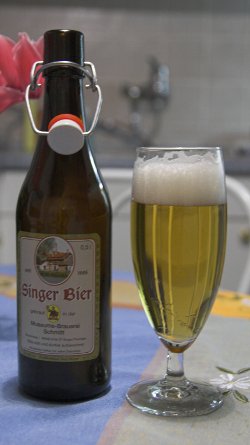Difference between revisions of "Museumsbrauerei Schmitt"
From German brewing and more
| (14 intermediate revisions by the same user not shown) | |||
| Line 1: | Line 1: | ||
| − | [[Image:Singen Von Aussen.jpg]] | + | {| style="width:800px" |
| − | [[Image:Singen Sudpfanne von unten.jpg]] | + | | |
| − | Singen Sudpfanne | + | |
| − | Singen Sudpfanne.jpg | + | These are pictures from a small brewery in |
| − | Singen Laeuterbottich.jpg | + | [http://maps.google.com/maps?f=q&source=s_q&hl=en&geocode=&q=Singen+thuringen+Germany&sll=47.820532,8.808804&sspn=0.080799,0.118103&ie=UTF8&hq=&hnear=Singen+Ilmtal,+Ilm-Kreis,+Thuringia,+Germany&ll=50.724612,11.057825&spn=0.004761,0.007381&t=h&z=17 Singen] (Thuringia, Germany). |
| − | Singen Kuehlschiff bild2.jpg | + | I first visited this brewery when I studied at the nearby University and returned in November of 2009. That's also when I took these pictures. |
| − | Singen Kuehlschiff bild1.jpg | + | |
| − | + | <div style="clear:both;"></div> | |
| − | Singen | + | |
| − | Singen Gastraum.jpg | + | [[Image:Singen Von Aussen.jpg|frame|center|The brewery as seen from the |
| − | + | road. The large building in the front is the tap room while the building | |
| − | + | behind houses the brewery. Note the hop trellis in the front of the tap | |
| − | + | room]] | |
| + | |||
| + | [[Image:Singen Eingang.jpg|frame|center|The entry to the brewery. It has | ||
| + | been operating since 1885. The large back drum next to the shed is an old | ||
| + | lauter tun]] | ||
| + | |||
| + | <div style="clear:both;"></div> | ||
| + | |||
| + | {| | ||
| + | |||
| + | | valign="top" | [[Image:Singen Kesselhaus.jpg|frame|A look towards the boiler room | ||
| + | (''Kesselhaus'')]] | ||
| + | |||
| + | | valign="top" | [[Image:Singen Dampfmaschine.jpg|frame| The old steam engine. This steam | ||
| + | engine used to provide mechanical power to the whole brewery though a system | ||
| + | of belts. It has been replaced by electrical motors.]] | ||
| + | |||
| + | |} | ||
| + | |||
| + | {| | ||
| + | |||
| + | | valign="top" | [[Image:Singen Sudpfanne von unten.jpg|frame|Looking at the kettle from the | ||
| + | brewery's floor. In front of the stairs, below the pipe sticking out of | ||
| + | the wall, would be the lautertun which was in need of repair. Aforementioned | ||
| + | pipe would drain the mash from the kettle into the lauter tun]] | ||
| + | |||
| + | | valign="top" | [[Image:Singen Sudpfanne.jpg|frame|The boil and mash kettle. This 2 vessel | ||
| + | brewery setup (mash/boil kettle and mash/lauter tun) was typical for small | ||
| + | breweries in the late 1800s (see [[[German Brewing between 1850 and 1900 : | ||
| + | Malting and Wort Production|brewing between 1850 and 1900]]).]] | ||
| + | |||
| + | |} | ||
| + | |||
| + | {| | ||
| + | |||
| + | | valign="top" | [[Image:Singen Sudpfanne innen.jpg|frame|The inside of the boil kettle. Note | ||
| + | the drag chains on the mash mixer.]] | ||
| + | |||
| + | | valign="top" | [[Image:Singen Laeuterbottich.jpg|frame|As mentioned before, the lauter tun | ||
| + | was out of commission and needed repair.]] | ||
| + | |||
| + | |} | ||
| + | |||
| + | |||
| + | {| | ||
| + | |||
| + | | valign="top" | [[Image:Singen Hofenseier.jpg|frame|Once the boil is complete the wort is run through a hopback (''Hopfenseier'') before it is pumped to the cool ship located under the roof]] | ||
| + | |||
| + | | valign="top" | [[Image:Singen Kuehlschiff bild2.jpg|frame|Cool ship]] | ||
| + | |||
| + | |} | ||
| + | |||
| + | [[Image:Singen Kuehlschiff bild1.jpg|frame|center|This brewery is one of the few | ||
| + | German breweries which still use a cool ship to cool the wort. The reason is | ||
| + | obvious: the exposure of a large wort surface to the ambient air carries a | ||
| + | high risk of contamination]] | ||
| + | |||
| + | {| | ||
| + | |||
| + | | valign="top" | [[Image:Singen Berieslungskuehler.jpg|frame|After the cool ship a cascade | ||
| + | chiller (''Berieslungskuehler'') was used to aerate and chill the wort to | ||
| + | pitching temperatures. This one is out of commission and the brewery now | ||
| + | uses a plate chiller. I was unfortunately not able to look at the fermeters | ||
| + | and lagering cellar]] | ||
| + | |||
| + | | valign="top" | [[Image:Singen Gastraum.jpg|frame|Inside the tap room. November is not | ||
| + | exactly a busy season and I didn't stay either. I bought a few bottles and | ||
| + | enjoyed them at home. The brewery is a very popular destination during the | ||
| + | warmer months. Especially on Ascension Day (the German Father's day) where | ||
| + | the male German population is on a pilgrimage to their favorite pubs and | ||
| + | beer gardens]] | ||
| + | |||
| + | |} | ||
| + | |||
| + | [[Image:Singer Pilsner.jpg|frame|center|The brewery brews only one type of beer: a | ||
| + | Pilsner.]] | ||
| + | |||
| + | |} | ||
Latest revision as of 04:00, 7 January 2010
|
These are pictures from a small brewery in Singen (Thuringia, Germany). I first visited this brewery when I studied at the nearby University and returned in November of 2009. That's also when I took these pictures.
|
